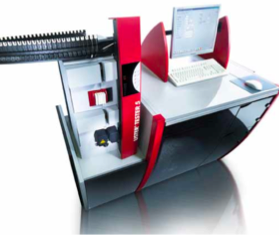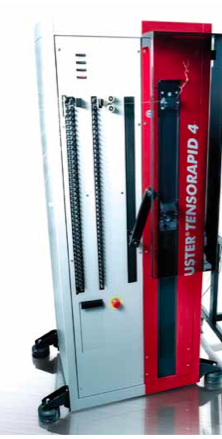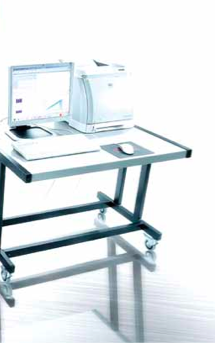By K. Gopalakrishnan
 Toyota Industries Corporation (TICO) and Uster have jointly announced that they signed a transaction agreement on February 20 under which TICO will raise the offer price to CHF 44 net per Uster share, an increase of CHF 6 per share compared to the price announced earlier in November last.
Toyota Industries Corporation (TICO) and Uster have jointly announced that they signed a transaction agreement on February 20 under which TICO will raise the offer price to CHF 44 net per Uster share, an increase of CHF 6 per share compared to the price announced earlier in November last.
Mr. Akira Onishi, Senior Managing Director and member of the Board of TICO, comments: “TICO is the ideal strategic partner for the sustainable development of Uster. We intend to create synergies with Uster’s excellent quality management system and superior sensing and information handling technologies and TICO’s expertise in spinning and weaving machinery so that both companies can deliver added value to customers. The public tender offer is in the best interests for Uster’s and TICO’s shareholders, employees, clients and suppliers. The transaction will lead to a successful future for the company under the leadership of the existing management.”
Dr. Geoffrey Scott, CEO and Member of the Board of Uster, says: “After a full evaluation of its strategic alternatives and thoughtful consideration, our Board believes that the transaction with TICO is in the best interests of our shareholders, customers and employees. I personally fully support the Board’s view and therefore commit myself irrevocably to tender my shares. The Board and Management are aligned in joining TICO in a transaction which delivers significant value to our shareholders and creates tremendous opportunities for our employees and clients.”
The dawn of a new era
 In November 2011, Toyota Industries Corporation announced an agreement to buy the remaining shares of the private equity fund Alpha, thereby reaching a controlling 50.34 per cent stake in Uster Technologies Ltd.’s share capital. As stipulated by Swiss law and the company’s articles of association, Toyota Industries has made a mandatory takeover offer at an offer price for all publicly held registered shares of Uster Technologies Ltd.
In November 2011, Toyota Industries Corporation announced an agreement to buy the remaining shares of the private equity fund Alpha, thereby reaching a controlling 50.34 per cent stake in Uster Technologies Ltd.’s share capital. As stipulated by Swiss law and the company’s articles of association, Toyota Industries has made a mandatory takeover offer at an offer price for all publicly held registered shares of Uster Technologies Ltd.
The Textile Machinery Division of Toyota Industries Corporation and Uster Technologies Ltd. are highly successful companies with leading positions in complementary markets. Thanks to the merger with Toyota Industries Corporation, Uster Technologies Ltd. will have access to new technologies and market segments, thereby strengthening its position as the leader in textile certification and quality control whilst broadening its coverage of the textile manufacturing market.
The company believes that the combination of the two companies’ unique portfolios in terms of technology and market expertise offers great potential for joint business development opportunities, from which all stakeholders, including existing and new customers, business partners and the highly skilled staff of Uster are likely to benefit.
The Uster Group is the leading high technology instrument manufacturer of products for quality measurement and certification for the textile industry. The group provides testing and monitoring instruments, systems and services that allow optimization and certification of quality through each individual stage of textile production; from the raw textile fiber, such as cotton, wool or synthetic filament yarns, to the final finished fabric. The group provides benchmarks that are the basis for trading of textile products at assured levels of quality across global markets.
Uster Technologies, was established in 1875 as an aerial telegraphy workshop in Uster (Switzerland), became an independent company in 2003 following the acquisition of the Zellweger Uster division of Zellweger Luwa by the management and funds advised by two private-equity investment companies. In 2006 Uster Technologies was acquired by its management and funds advised by Alpha Beteiligungsberatung GmbH & Co. KG. In 2007 Uster Technologies became a public company by listing its shares on the SIX Swiss Exchange.
Sales and support network
 Headquartered in Uster, Switzerland, the Uster Group operates through a worldwide market organization complemented by technology centers. It has sales and service subsidiaries in the major textile markets and technology centers in Uster, Knoxville (USA) and in Suzhou (China). The Swiss, American and Chinese facilities are certified to the ISO 9001 standard.
Headquartered in Uster, Switzerland, the Uster Group operates through a worldwide market organization complemented by technology centers. It has sales and service subsidiaries in the major textile markets and technology centers in Uster, Knoxville (USA) and in Suzhou (China). The Swiss, American and Chinese facilities are certified to the ISO 9001 standard.
The Uster facility is focused on products for yarn testing and on fabric quality assurance whereas the Knoxville facility is focused on products for fiber testing and gin process control. The Suzhou facility, set up in 2005, is focused on low-cost development and assembly operations as well as allowing the group to establish a local supply chain network to complement its global supply chain management activities.
In 2011, Uster Technologies Ltd. achieved excellent performance levels surpassing the previous highest sales achieved in 2007 before the combined textile and financial market crisis. Sales of products and services in all markets, both for textile laboratories and manufacturing processes, contributed to these positive developments. New record sales came from the combined excellent performance of the new third generation of Uster yarn clearers and substantial increases in demand for laboratory yarn and fiber testing instruments.
USTER QUANTUM 3, sold through textile machinery manufacturers, meets the need of textile producer to maximize utilization of highly priced cotton by efficiently manufacturing yarns with optimal and consistent quality levels.
Focus on quality, process automation
The positive market developments already seen in the first half of the financial year 2011 continued. Demand for quality measurement and certification products around the world was maintained at a high level. In China and India, as well as in additional Asian markets, the textile industry makes a significant contribution to gross domestic product (GDP) and therefore continues to be a beneficiary of well-directed government programs. Furthermore, the shift to automated production in China gained further momentum due to rising labor costs and in order to optimally use high price draw materials.
Producers generally put greater emphasis on quality aspects as a means of achieving adequate prices relative to the corresponding quality and to minimize waste. In the cotton classing market, the China Fiber Inspection Bureau (CFIB) and the United States Department of Agriculture (USDA) further accomplished their ongoing expansion and replacement plans.
Uster Technologies serves the world’s textile market, the third largest market in the global economy. This dynamic industry relies on the company’s offering for testing and quality control instruments. Since consumers are becoming more demanding about the quality of the textile products they use, manufacturers have a vested interest in measuring and monitoring all production processes at every stage of the textile industry value chain.
Comprehensive expertise and a constant quest for precision and perfection position Uster Technologies as the unrivalled market leader. Uster offers producers unique know-how and expertise in meeting current and future industry requirements as well as in applying state-of-the-art technology that enhances production efficiency, quality excellence and competitiveness.
Operational review
 In 2011 all major markets responded positively to the improving economic environment, leading to increased levels of business, even though the outlook was blurred by the intensifying debt crisis affecting major economies in the second half of the reporting period. These developments renewed fears of an upcoming inflation cycle and started to depress consumer spending.
In 2011 all major markets responded positively to the improving economic environment, leading to increased levels of business, even though the outlook was blurred by the intensifying debt crisis affecting major economies in the second half of the reporting period. These developments renewed fears of an upcoming inflation cycle and started to depress consumer spending.
Textile markets worldwide were not yet affected by these trends and continued to grow. Producers intensified their focus on improving both the level and consistency of quality in their operations and manufactured products in order to maximize earnings by enhancing efficiency and minimizing waste. China and India performed strongly and set the course within the industry. In parallel, rising labor costs drove a switch from manual systems to highly automated and integrated production processes. The result was increased demand for automated production machinery, including automatic winding machines, further boosting the demand for the associated quality measuring and control instruments.
Furthermore, local markets in China and in other Asian countries such as Vietnam, Cambodia and Indonesia grew well above the average industry rates. In response to the needs of these emerging markets Uster Technologies expanded its offering and services to the mid-market segment with new quality control systems featuring the latest Uster state-of-the-art technology and expertise.
Record sales
 In the financial year 2011, Uster Technologies posted strong performance levels and achieved new record sales. The group’s gross sales grew to CHF 192.5 million, an increase of 44.9 per cent compared to the previous year result of CHF 132.8 million. Overall sales in the Asian markets contributed 67.6 per cent to total gross sales (2010: 67.3 per cent); Europe and Americas generated 24.1 per cent and 8.3 per cent of total sales (2010: 21.7 per cent and 11.0 per cent). This growth was mainly driven by improved operational leverage based on the group’s lean organization. The cash flow from operational activities was mainly used to pay down debt to CHF 70 million, underlining the group’s strong cash generation ability.
In the financial year 2011, Uster Technologies posted strong performance levels and achieved new record sales. The group’s gross sales grew to CHF 192.5 million, an increase of 44.9 per cent compared to the previous year result of CHF 132.8 million. Overall sales in the Asian markets contributed 67.6 per cent to total gross sales (2010: 67.3 per cent); Europe and Americas generated 24.1 per cent and 8.3 per cent of total sales (2010: 21.7 per cent and 11.0 per cent). This growth was mainly driven by improved operational leverage based on the group’s lean organization. The cash flow from operational activities was mainly used to pay down debt to CHF 70 million, underlining the group’s strong cash generation ability.
Management remains committed to investing around 10 per cent of total sales in R&D, thereby ensuring continued sustainable growth of the organization’s operations. In 2011 expenses for R&D amounted to CHF 18.2 million, which corresponds to 9.4 per cent of total sales (2010: CHF 14.9 million; 11.2 per cent).
Increased sales of all product groups contributed to the solid results in 2011 and clearly exceeded the levels achieved in the prior year. Sales to textile machinery manufacturers and producers of automated winding machines were strong, thanks to the launch of the new third generation of USTER QUANTUM 3 clearer. This innovative device hit the markets at a favorable time when the textile industry was shifting back into a growth gear and new investments in quality returned to the focus of textile machinery manufacturers as well as textile producers.
In order to meet the high demand, the Uster teams successfully organized an efficient use of all available resources. This included the commissioning and fast ramp-up of new automated manufacturing systems, a major step forward in operations that allows for significant improvements in productivity and flexibility, along with assuring yet further improvements in the level and consistency of quality, performance and reliability of our own products. A further positive impact arising from the group’s lean and flexible business model is an inherent expertise in supply chain management and working with outsourcing partners.
The group specialists managed to rapidly build up a completely new supply chain as well as tooling and quality processes for the new product group. This was achieved in spite of some challenges early in the year with the supply of electronic components resulting from ‘empty supply streams’ after the crisis along with some disruptions following the Tsunami in Japan.
These challenges were mitigated through the diligent and systematic focus of manufacturing and supply chain teams to resolve issues and to ensure minimal impact on the supply of products to customers. They deserve special congratulations for their outstanding efforts.
In customer markets, high raw material prices supported demand for quality measurement and certification products. In the classing business, Uster further intensified its dedicated support to the expansion and replacement programs of USDA and the China Fiber Inspection Bureau (CFIB). Besides, the company teams secured additional business in further cotton growing markets such as India, Africa and Central Asia, thereby diversifying the customer base and confirming the trust in Uster as the authority in cotton classing.
Demand for testing systems, both in textile laboratories and in the manufacturing process, continued to increase during the reporting period as textile producers expressed a need for efficient manufacturing at optimal and consistent quality levels.
In the customer service business, the Uster Group strengthened its strong relationships with its wide textile retailer base, enhancing interest in a number of value-adding services, including Intelligent Sourcing, USTERIZED certification and Uster Statistics.
The after-sales service business was maintained in line with instrumentation sales.
Demonstrated leadership
Uster Technologies continued to offer extensive promotional and educational programs for its products groups. These programs have been specifically designed to enhance customers’ understanding of how to manage quality, productivity and profitability with the help of Uster instruments, Uster best practices and Uster Statistics. The company also intensified its relationships with major textile universities in China, along with publishing a textbook entitled “Textile Measuring Technology and Quality Control” written by Richard Furter. This will represent a proud legacy recognizing his acknowledged know-how and expertise.
Uster Technologies Ltd. was present at both the important trade fairs in 2011 – Shanghaitex in China and ITMA in Barcelona. Uster marketing and technology experts took advantage of the chance to address high-level industry audiences and highlight the added value that its product and service portfolio offers to customers.
At ITMA, the central theme of the group’s presence was dedicated to the introduction of the new Uster Total Testing approach, under the banner “From Uncertain Results to Predictable Profits”. Total Testing is based on a unique combination of laboratory testing, process monitoring and know-how, and it provides textile companies with unique possibilities to transform their operations and give the opportunity to assure sustainability of their business.
Today textile producers must excel in all areas of their operations in order to achieve sustainable growth and results. The essential need is to strike the right balance between minimizing costs and consistently achieving the required quality. This demands proper control of yarn quality.
Outlook
 Uster Technologies is currently expecting that the demand for quality measurement and certification products as a means to sustained profitability for textile producers will continue. In addition, the focus on process optimization and the trend for modernization and automation of textile production equipment in China will remain as driver of growth.
Uster Technologies is currently expecting that the demand for quality measurement and certification products as a means to sustained profitability for textile producers will continue. In addition, the focus on process optimization and the trend for modernization and automation of textile production equipment in China will remain as driver of growth.
The textile industry is known to be cyclical, and the consensus among the suppliers to the industry is that they will see a downturn in the cycle in 2012, but more of a soft landing rather than the crisis that was seen in 2008-2009. The Uster management supports this view, on the assumption that there is not a further financial crisis or major economic disruption.
But as the company has demonstrated in the past, it will be one of the last to go into the cycle and one of the first to come out after recovery. As a result, the management expects to see a decline in sales in 2012, but strong profitability will be maintained. Experience gained over the past years along with a proven track record of delivering strong financial performance underpins this view.
Assuming the takeover offer of Toyota Industries Corporation is supported by Uster Technologies Ltd.’s shareholders, it is likely that the strategic collaboration between the two companies will be further intensified.
The joint business development projects already initiated in 2009 are targeting synergies arising from both companies’ unique technology portfolios and excellent market positions in complementary industry segments and are expected to yield further growth potential in the near future.
In the future, Uster Technologies Ltd. seeks to offer textile producers unique know-how and expertise in meeting current and future industry requirements as well as in applying state-of-the-art technology that enhances customers’ production efficiency, quality excellence and competitiveness